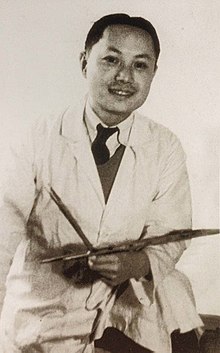Zhang Chongren
This article needs additional citations for verification. (December 2007) |
Zhang Chongren | |
|---|---|
| Chinese name | |
Hanyu Pinyin | Zhāng Chōngrén |
| Wade–Giles | Chang Ch'ung-jen |

Zhang Chongren (27 September 1907 – 8 October 1998), also known as Chang Chong-jen, was a Chinese sculptor best remembered in Europe as a friend of Hergé, the Belgian cartoonist and creator of The Adventures of Tintin. The two met when Zhang was an art student in Brussels.[3][4][5] Zhang served as the inspiration for Chang Chong-Chen, a recurring character in the Tintin stories.
Early life
Zhang was born the son of a gardener in 1907 in
Influence on Hergé
Hergé's early albums of .
At the close of the newspaper run of Cigars of the Pharaoh, Hergé had mentioned that Tintin's next adventure (The Blue Lotus) would bring him to China. Father Gosset, the chaplain to the Chinese students at the University of Leuven, wrote to Hergé urging him to be sensitive about what he wrote about China. Hergé agreed, and in the spring of 1934 Gosset introduced him to Zhang Chongren. The two young artists quickly became close friends, and Zhang introduced Hergé to Chinese history and culture, and the techniques of Chinese art. Of similar age, they also shared many interests and beliefs. Hergé even promised to give authorship credits to Zhang in the book, but Zhang declined the offer. As a result of this experience, Hergé would strive, in The Blue Lotus and subsequent Tintin adventures, to be meticulously accurate in depicting the places Tintin visited.
As a token of appreciation, Hergé added the character "Chang Chong-Chen" (Tchang in original French-language version) to The Blue Lotus.[1]
As another result of his friendship with Zhang, Hergé became increasingly aware of the problems of
Return to China
At the end of his studies in Brussels in 1935, Zhang made a tour of France, Britain, the Netherlands, Germany, Austria and Italy before returning home to China. Upon his arrival back in Shanghai in 1936, Zhang held a number of shows exhibiting his drawings and sculptures. He also established the Chongren Studio to further his art and to teach.
Hergé lost contact with him during the invasion of China by Japan (which is usually regarded as the start of the
After the economic liberalization of China in 1979, Zhang received widespread acknowledgment in the Chinese art community. A collection of his oil paintings and sculptures were published and in his later years, Zhang worked as an editor and translator of several books on art. Among the portraits he painted are those of Chinese paramount leader Deng Xiaoping and French President François Mitterrand.
Zhang returned to Europe for a reunion with Hergé in 1981 on the invitation of the French government. In 1989 he received French citizenship[1] and settled down to teach in the Paris suburb of Nogent-sur-Marne, where he died in 1998. Shortly after his death, a memorial museum dedicated to him was established in Qibao, Shanghai. A number of his paintings and sculptures are held in the China Museum of Fine Art in Beijing and the China Museum of Revolutionary Warfare.
References
- ^ a b c d Bocquet, José-Louis, and Fromental, Jean-Luc. The Adventures of Hergé (Drawn and Quarterly, 2011).
- ISBN 978-7-80740-500-9.
- )
- Jakarta Post. Archived from the originalon 3 October 2010. Retrieved 26 May 2010.
- ^ "Tintin at the top". The Times. Retrieved 26 May 2010.
